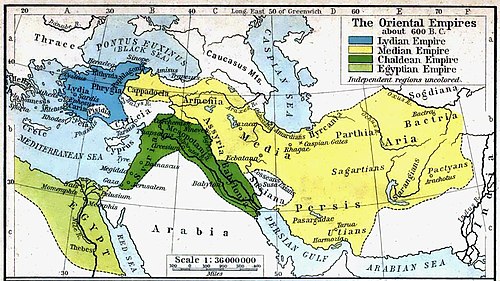Facts for Kids
Parthian is an ancient Eastern Iranian language that served as the primary means of communication in the Parthian Empire and has historical significance in understanding the region's culture and evolution.
Overview
Trade And Economy
History And Origins
Art And Architecture
Religion And Beliefs
Cultural Contributions
Military Strategies And Warfare
Political Structure And Governance
Relations With Neighboring Civilizations

Inside this Article
Ahura Mazda
Creativity
Technology
Literature
Silk Road
Sanskrit
Persian
Emperor
Are
Did you know?
📜 Parthian was used as a literary and spoken language in ancient Persia during the Parthian Empire.
🔤 Parthian is categorized as an Eastern Iranian language and is closely related to Middle Persian.
💬 The language was widely used as a lingua franca across the region, facilitating communication between diverse groups.
📚 Parthian inscriptions can be found on coins, monuments, and various historical artifacts.
🌍 It was spoken primarily in what is now Iran and parts of Afghanistan and Turkmenistan.
✍️ The script used for Parthian included both the Aramaic script and the Pahlavi script.
🐾 Parthian has contributed to the vocabulary and development of modern Persian.
⚔️ The language reflects the cultural and political heritage of the Parthian *Kingly* dynasty.
👂 Parthian is largely a dead language, having evolved into Middle Persian after the fall of the Parthian Empire.
🏺 The study of Parthian is crucial for understanding the history and culture of ancient Iran.
Introduction
️ The Parthians were known for their strong cavalry and rich culture. Parthian belongs to the Indo-Iranian group of languages, which means it is related to languages like Persian and Sanskrit. 🌏
While it is not spoken anymore, scholars study it using inscriptions and coins. Parthian was mainly written in Aramaic script, which makes it even more interesting! 📜
Learning about Parthian helps us understand ancient history and many different cultures!
Trade And Economy
Its location along the Silk Road allowed it to trade valuable goods like silk, spices, and precious metals. 📦
Cities like Ctesiphon thrived as marketplaces bustling with merchants from various lands. The Parthians exchanged their products for items from Greece, India, and China! 💎
This trade brought wealth and prosperity and encouraged cultural exchange between civilizations. As a result, learning about Parthian trade helps us recognize the importance of trade routes in world history!
History And Origins
️ The empire, which was founded by Arsaces I, was established in 247 BCE. 📅
The language likely originated from the Old Iranian spoken by the early nomadic tribes in northeastern Iran. The Parthian people engaged in trade and formed connections with the neighboring Greek and Roman empires. 🌉
Notably, the Parthians fought against the Romans, and their unique language helped them maintain their identity. Over time, Parthian evolved, and by the 3rd century CE, it began to transform into Middle Persian. 📚
Learning about its origins is important for understanding how languages change over time!
Art And Architecture
They created stunning sculptures, jewelry, and pottery, showcasing their talent. Many sculptures represented their kings, gods, and animals, making art an essential part of their culture. 🗿
Parthians built impressive structures, like their grand cities and temples, often using mud bricks and stone. The ruins of cities like Nisa show the beautiful designs and styles of the Parthians. Their artistic legacy also influenced neighboring cultures! By studying Parthian art and architecture, we learn about the creativity and skills of ancient peoples!
Religion And Beliefs
They followed Zoroastrianism, a faith founded by the prophet Zoroaster, which emphasized the struggle between good and evil. They believed in one God called Ahura Mazda. 🙏
Additionally, the Parthians honored various gods from other cultures, such as Greek and Babylonian gods. Temples were built to celebrate these deities, and religious festivals were an essential part of society. 🏛
️ Learning about Parthian religious beliefs allows us to appreciate how ancient civilizations understood the world around them!
Cultural Contributions
The Parthians loved to create magnificent sculptures and pottery, often depicting their gods and daily life. Many Parthian coins feature images of kings and important symbols, which tell us much about their society. 💰
They also contributed to the famous Silk Road, a trade route connecting Asia to Europe, helping spread goods and ideas! 🌏
Parthian stories and poems celebrated heroic deeds and preserved their history. This rich culture influenced neighboring civilizations and shaped what we know today. Learning about Parthian contributions helps us appreciate the diversity of ancient cultures!
Military Strategies And Warfare
They often employed a strategy called "Parthian shot," where mounted archers would shoot arrows while riding away from their enemies. 🎯
This made it hard for opponents to catch them! Parthians used sturdy cavalry and heavy cataphracts (armored soldiers) to defend their empire, which was essential during battles against the Romans. 🏹
Their military prowess made them a key player in ancient warfare, and their strategies are studied by historians today. Learning about Parthian warfare helps us understand ancient military tactics!
Political Structure And Governance
️ It was a feudal system, meaning it was made up of local kings who ruled different regions but acknowledged the authority of the central King of Kings. 👑
These local rulers had power, but they also had to pay taxes to the emperor and provide soldiers for the army. The empire was vast and covered various regions, which is why cooperation among local leaders was crucial. 🏰
This system allowed Parthia to manage various cultures and languages under its rule. Understanding their governance helps us learn about how empires maintained order!
Relations With Neighboring Civilizations
At times, they were allies, but often, they were rivals. The Parthians faced many battles against Rome, with famous conflicts like the Battle of Carrhae in 53 BCE. ⚔
️ In addition to military interactions, they traded with various cultures, sharing ideas, technology, and art. This exchange enriched both Parthian and neighboring civilizations! 🌍
Understanding these relations helps us see how interconnected ancient societies were, shaping history in unexpected ways!

